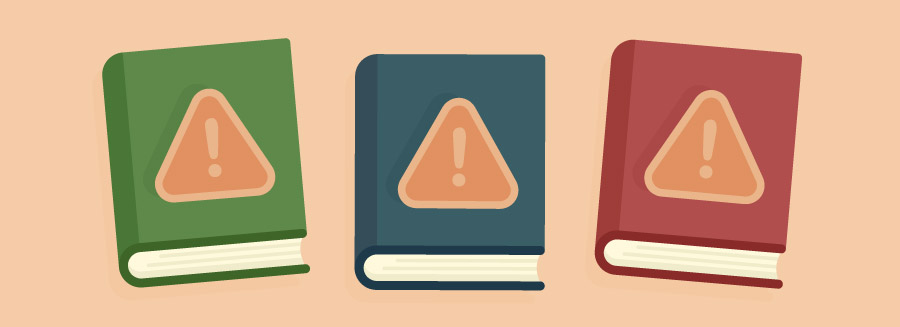There is significant disagreement among educators about whether books that include depictions of traumatic events should come with trigger/content warnings. Let’s explore the different perspectives and consider whose perspectives might be missing from this debate.
Censorship and the “Slippery Slope”
The main argument against adding content warning labels to books is that this is a form of censorship. The NCTE’s Position Statement Regarding Rating or “Red-Flagging” Books states, “Letter ratings, content warnings, and all forms of “red-flagging”—whether in classroom, school, or community libraries, or inserted via mandate into course syllabi—constitute blatant forms of censorship.” Their argument is that “red-flagging” a book reduces a complex story to one isolated part of that story and therefore ends up restricting access to books for certain students. They warn that this is a “slippery slope toward censorship.”
A related argument against labeling books based on content is in the value-laden designation of “controversial” or “mature.” What’s considered appropriate varies from person to person and to make that decision for someone else could be understood as a rights violation. The AASL’s Position Statement on Labeling Practices states, “Labels that make determinations about a book’s content are an infringement of a learner’s First Amendment rights to free speech and their ability to make determinations about what content is appropriate for them. Instead, school librarians should support each learner’s right to make determinations about content.” In this Twitter conversation about the pros and cons of trigger/content warnings, many educators stated that a “heads-up” in the form of a one-on-one conversation with a student or a book-talk are better than a label on the book.

The Use/Misuse of Labels
The AASL position statement also argues that any type of labeling should be used with extreme caution as it may function to further stigmatize marginalized groups. For example, imagine if a book was labeled with a topic/genre label like “LGBTQ.” In this case, the label may actually separate the books from the rest of the collection, ultimately narrowing the audience or making these books less accessible. Additionally, labels like this can be problematic and offensive. For example, a label like “Urban” can be used in highly stereotypical and othering ways. While labels like this are not technically content warnings, they can ultimately function in this way because caregivers may interpret the labels as a sign of “inappropriate” material and prevent their children from checking out these types of books.
We should also be cognizant of the fact that the use of content warnings is likely to lead to their misuse. The argument is that if librarians begin to label books with content warnings for things like sexual abuse or suicide, it’s not difficult to imagine some caregivers advocating for labels that denote any sexual content at all–especially LGBTQ sexuality–or any form of violence in the book. This could lead to a situation where nearly every single YA book is labeled as inappropriate in some way. What types of content warrant a label and what types do not? We can imagine vastly different answers to that question depending on where we are in the country. If a vocal group pushes for labels on any topic they find objectionable, they are likely to succeed in many districts. For example, some parents may push for content warning labels on any book that features or even mentions trans people, thus further marginalizing an entire group of people as “inappropriate.”
The Case for Trigger Warnings
These are strong arguments against labeling. One final common argument against trigger warnings goes something like this: Life is complex and sometimes distressing. But those experiences help us grow and learn how to process tough situations. We cannot and should not shield young people from the realities of the world. We need to respect young people enough to trust that they will be able to handle these topics. To this point specifically, it seems that the question needs to come back to: what is the difference between content labeling in general and trigger warnings specifically? The argument that content warnings shelter young people from important perspectives seems to misrepresent the intention of trigger warnings and nature of trauma responses. For those who have experienced trauma and live with PTSD, a trigger can result in a panic attack or another physiological response that can take hours, days, or weeks to recover from. This is not the same as a student feeling uncomfortable, challenged, sad, or angry because of something they read.
Those in favor of trigger warnings are not attempting to shield students from complicated or distressing realities. The intention is to provide students with the agency to moderate their own feelings and interactions with a text. A trigger warning does not tell students to avoid a book–this might be their choice, but not necessarily–it allows them to emotionally steady themselves for what is ahead. It prevents them from being caught off guard. Certainly, educators cannot predict what will trigger traumatic memories in students, but is this a reason to abandon the effort? We know, from listening to survivors, that there are certain types of triggers that are easier to anticipate–specifically, those that depict events likely to result in PTSD. These include (but are not limited to) suicide, self harm, sexual/emotional/verbal/physical/child/domestic abuse, torture, war, ableism, racist/sexist/homophobic/transphobic bullying or assault, addiction, death of a parent/sibling/child, murder, and gun violence. Even for those students who have not experienced trauma, these warnings can help prepare them for what’s ahead.

Topics, Trauma, and the Missing Perspective
When a teacher/librarian/school is considering whether to label books with trigger/content warnings, it seems that an essential distinction to be made is between trauma and topics. Labeling a book as “mature” or indicating that it includes sexual content is labeling based on a topic. It is not a trigger warning. It does not provide useful information to a trauma survivor, and it is likely to stigmatize the book in the eyes of students or parents. On the other hand, if the warnings we include are specific to traumatic events, we are providing information without veering into the realm of value/moral judgements. Including these warnings inside book covers (vs. on the cover) provides a “middle-ground” between easily accessible warnings and “red-flagging.”
As with any complicated issue, there is no elegant answer to this debate. There are risks in any direction we choose. One way to anchor us is view the issue through the lens of the groups with the least power to dictate the organizational response. We have to ask ourselves, whose voices are missing or silenced? In this case, there is a group’s voice that seems to be missing from this debate: students. I encourage any educator struggling with this decision to ask your students what they think and what kinds of warnings they might appreciate. Their perspective, on this issue and all issues that concern them, will be your most reliable map in choosing a path forward.






